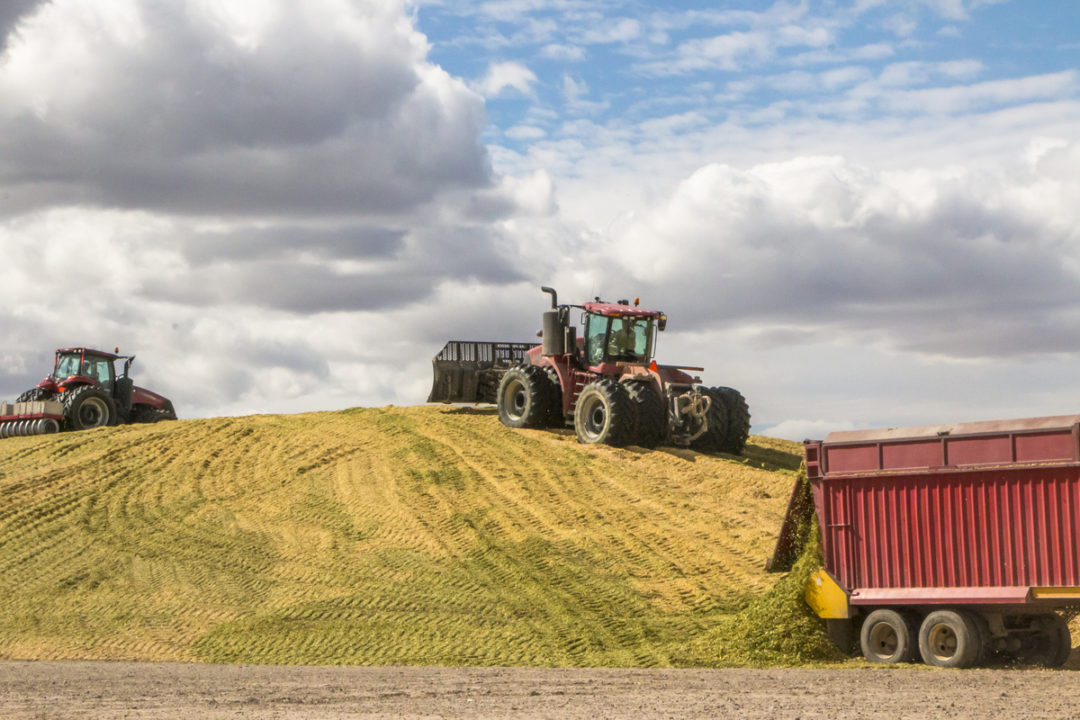It’s common for dairy producers to experience a “fall slump,” or a time when cows fail to reach their full production potential. Producers also might notice decreased feed intake or loose manure. This is usually caused by an abrupt change from last season’s corn silage to recently fermented corn silage. A similar slump also can occur when switching from old crop haylage in the spring.
It’s possible to avoid dips in milk production due to silage changes. A few simple changes can help prevent reduced health and performance outcomes.
Never feed spoiled silage
The tail end of the silage pile is often lower quality. It’s hard to keep a smaller pile well covered and maintained, which can lead to spoilage.
If you see any signs of spoilage, avoid the temptation to feed the spoiled silage — even in small amounts. Feeding spoiled silage can lead to herd health issues, reduced feed intake and decreased production.
Furthermore, feeding spoiled silage has been shown to damage the rumen mat — where fiber degradation in cattle occurs. When rumen function is impaired, cattle struggle to absorb nutrients from any feed sources. Including just 5.4% of badly spoiled silage in the ration of beef steers reduced dry matter intake (DMI) by 1.3 pounds per day and reduced neutral detergent fiber (NDF) digestibility of the whole ration by seven points, according to a study by Kansas State University.
Spoiled silage can be used at lower inclusion rates in lower-risk groups of animals — like heifers or beef cows — or spread on fields. If you suspect spoilage, consider adding a yeast cell wall supplement high in MOS (mannan-oligosaccharides and β-glucans), which can help bind undesirable bacteria and certain mycotoxins. These products can be a low-cost “insurance” policy to help get through periods of less-than-ideal silage quality.
New silage can be less digestible
A contributing factor to a fall slump is lower starch digestibility in newly fermented corn silage. When harvested above 32% dry matter (DM), the starch in corn starts to become less digestible. Flint varieties also have lower starch digestibility than floury ones.
To help improve starch digestibility, allow corn to ensile for at least four months before feeding. This time helps break down the starch-protein matrix formed by the cross-linking of zein proteins with starch granules. With additional weeks in storage, the starch becomes more available for digestion.
Break down plant fiber with inoculants
To improve fiber digestibility in silage, use a research-proven silage inoculant containing enzymes to help break down plant fiber and increase digestibility. Look for enzyme activity levels declared on the product label and research supporting effects on digestibility when choosing forage inoculants.
In the long term, a good inoculant can help improve stability of the silage. For instance, Lactobacillus buchneri NCIMB 40788, applied at a minimum of 400,000 colony-forming units (CFU) per gram of silage or 600,000 CFU per gram of high-moisture corn (HMC), is the only inoculant bacteria strain reviewed by the FDA and allowed to claim improved aerobic stability.
The high dose rate L. buchneri NCIMB 40788 technology prevents spoilage yeast growth, keeping the silage stable, and prevents mold and reduces mycotoxin risks. Feeding unstable and spoiled silage can decrease digestibility and animal production, lower herd health and, in some instances, have negative effects on reproductive efficiency.
Optimize rumen function
During this time, herds are likely to be vulnerable to subacute ruminal acidosis (SARA) due to high levels of fermentable sugars in the newly ensiled silage. Supplementing feed with an active dry yeast (ADY) probiotic can help maintain a healthy pH level and improve fiber digestibility in the rumen.
Results from multiple trials show cows fed Saccharomyces cerevisiae CNCM I-1077 had more stable rumen pH profiles, produced an increase of 2.1 pounds of 3.5% fat-corrected milk (FCM) and were more efficient than controls. Preventing SARA can help improve milk component yield (MCY) as well. Greater meal frequency is positively correlated to milk fat percentage. In addition, milk and component yield may be improved when cows are able to increase the frequency of meals, resulting in smaller meals, which results in more consistent nutrient intake.
S. cerevisiae CNCM I-1077 was proven in research to improve cows’ ruminal pH pattern and help ensure they spend more time above the SARA threshold. Keeping ruminal pH at the right level can make a big difference as an operation transitions to a newly fermented silage pile.
Based on lactating dairy cow performance trials in North America, S. cerevisiae CNCM I-1077 has been shown to improve milk component yield by 7.8%. Even at component pricing of $1.91 for butterfat and $2.84 for protein, that means for every 100 cows an additional $71 of income per day or $25,915 each year.
Changeover gradually
Finally, change silage piles gradually over a two-week or four-week period. New silage can be introduced as 25% of the silage portion of the ration in the first three days, then 50% of the ration the next three days, and so on until the transition is complete. Working alongside your nutritionist, adjust the ration to balance changes in DM and nutrient content. Routine testing of new forages for DM, kernel processing score and nutrient content is recommended to help tweak the ration based on the changing composition.
These steps are focused on easing the transition and giving the ensiling process time to break down the crystalline structure of starch to make it more available for digestion. Understanding the reasons for a fall slump in milk production can help you keep milk production steady while maintaining cattle health and fertility.
References omitted but are available upon request. Click here to email an editor.












